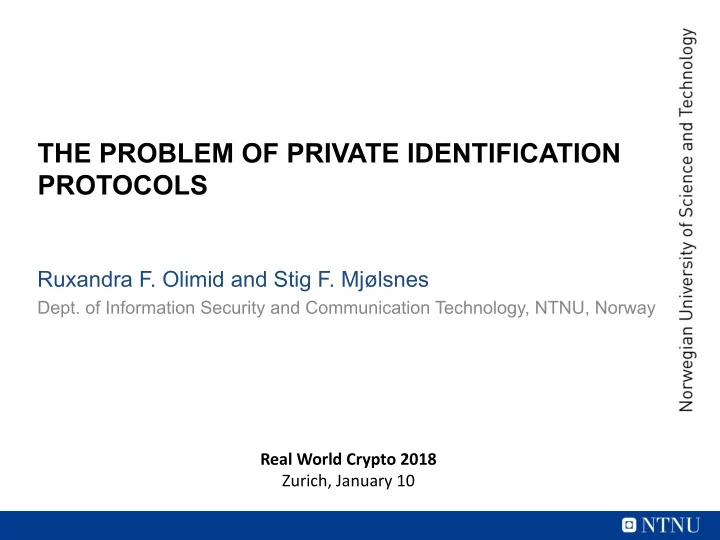

THE PROBLEM OF PRIVATE IDENTIFICATION PROTOCOLS Ruxandra F. Olimid and Stig F. Mjølsnes Dept. of Information Security and Communication Technology, NTNU, Norway Real World Crypto 2018 Zurich, January 10
Motivation - LTE 2
LTE - Subscriber’s Identification (IMSI,K) (IMSI,K) IMSI (International Mobile Subscriber Identity) MCC MNC MSIN (Mobile Country Code) (Mobile Network Code) (Mobile Subscriber Identification Number) 3
LTE - Subscriber’s Identification IMSI Identification Subscriber UE IMSI TMSI 1 UE TMSI 2 eNodeB 4
LTE - Privacy Breach Identity Request (IMSI) Identity Response (IMSI) eNodeB UE [. . . ] requests the user to send its permanent identity. The user's response contains the IMSI in cleartext. This represents a breach in the provision of user identity confidentiality . [ETSI TS 133 401 V14.4.0 (2017-10)] 5
Experimental Work • S.F.Mjølsnes, R.F.Olimid: Easy 4G/LTE IMSI Catchers for Non- Programmers, MMM-ACNS 2017 S.F.Mjølsnes, R.F.Olimid: Experimental Assessment of Private • Information Disclosure in LTE Mobile Networks, Secrypt 2017 6
Experimental Work Identity Request (IMSI) Identity Response (IMSI) eNodeB UE 7
Our LTE IMSI Catcher • eNodeB_Jammer: causes the UE to detach from the serving cell it camps on • eNodeB_Collector: masquerades as an authorized eNodeB running on the (second) highest priority frequency , but with higher signal power, causing the UE to try reselection and expose the IMSI 8
Tools : Hardware • Software radio peripherals (USRPs) – Ettus B200mini + antennas [https://www.ettus.com/product/details/USRP-B200mini] • Computers (access and core network) – Standard desktops or laptops: Intel NUC D54250WYK (i5-4250U CPU@1,30GHz), Lenovo ThinkPad T460s (i7-6600U CPU@2,30GHz) • Mobile terminals: – Samsung Galaxy S4 device, used to find the LTE channels and TACs used in the targeted area – Two LG Nexus 5X phones running Android v6, used to test our IMSI Catcher • SIM cards 9
Tools: Software • LTE Emulator: – Open Air Interface (OAI), an open source software that provides a (partially) standard compliant implementation of LTE • Service Mode: – Dial *#0011# on Samsung Galaxy S4 device – Read configuration of the commercial network: EARFCN DL, TAC, MCC, MNC, Cell ID 10
Construction • Phase 1. Gather the configuration parameters: – Find the EARFCN DL and TAC (using the Samsung device) – Run eNodeB_Jammer using MCC, MNC and the EARFCN DL of the commercial cell – Read new EARFCN DL after reselection • Phase 2. Configure and run the LTE IMSI Catcher: – Run eNodeB_Collector using MCC, MNC and the new EARFCN DL after reselection in the commercial network, but a different TAC – Run eNodeB_Jammer configured as in Phase 1 11
Results • Low-cost IMSI Catcher (< 3000 EUR): – COTS hardware and readily available software only – No (or very basic) changes in the source code 12
Results • Behaviour: – Denial-of-Service (DoS) until reboot - cause 3 ( Illegal UE ) – Downgrade to non-LTE services - cause 7 ( EPS services not allowed ) – Reconnection to the commercial network - cause 15 ( No suitable cells in tracking area ) 13
Similar Work [NDSS 2016] 14
IMSI Catchers in the Real World 15
”Real World” IMSI Catchers [Aftenposten, Dec.16 2014] 16
[http://www.rayzoneg.com/en.piranha.html] ”Real World” IMSI Catchers 17
”Real World” IMSI Catchers [https://theintercept.com/2016/09/12/long-secret-stingray-manuals-detail-how-police-can-spy-on-phones/] 18
The cryptographic problem • S.F.Mjølsnes, R.F.Olimid: The challenge of private identification, iNetSec 2017 (to appear) 19
The Problem ( How) Can we construct efficient and scalable secure identification mechanisms in (mobile) communication systems? (ID 1 ,K 1 ) (IMSI i ,K i ) (ID i ,K i ) (ID 2 ,K 2 ) … ... ... (ID n ,K n ) Subscriber Provider Output: (ID i ,K i ) We decouple the protocol from registration and authentication , to gain independence in design and analysis - the private identification challenge becomes a general standalone problem 20
Public Key - Trivial Solution ID 1 ID i ID 2 pk … ... ... ID n Subscriber Provider sk Enc pk (ID i ) Dec sk (Enc pk (ID i )) = ID i No PubKey 21
Key Search - Linear Solution (ID 1 ,K 1 ) (ID i ,K i ) (ID 2 ,K 2 ) … ... ... (ID n ,K n ) Subscriber Provider r j ← R R *key-indistinguishable MAC r j , Enc Ki (r j ) Try all {K i } until successfully Linear decryption of r j time Output: (ID i ,K i ) [Weis, Sarma, Rivest, Engels - Security and Pervasive Computing’03] [Alwen, Hirt, Maurer, Patra, Raykov - Anonymous Authentication with Shared Secrets’14] 22
Related Work • Models and definitions: • Mobile Networks, include authentication [Alwen et al.’14, Abadi & Fournet’15] • RFIDs [Vaudenay’07], [Canard et al.’10], [Hermans et al.’14], [Yang et al.’17] • Mobile networks (LTE): • Several IMSIs for each USIM [Kahn & Mitchel’15] • New temporary identifiers: DMSI (Dynamic Mobile Subscriber Identities) [Choudhury et al.’12], PMSI (Pseudo Mobile Subscriber Identities) [Broek et al.’15], CMSI (Changing Mobile Subscriber Identities) [Muthana &Saeed.’17] • Public-key solutions [Arapinis et al.’12], [Hermans et al.’14], [Chandrasekaran et al.’17] • RFID: • Linear complexity in the number of subscribers [Weis et al.’03], • Surveys [Jules’06], [Langheinrich.’09], [Song et al.’09], [Song et al.’11], [Yang et al.’17] 23
Summary • 4G/LTE IMSI-catchers – is IMSI-catching a bug or a feature? – this problem should be considered for 5G and beyond • Drawbacks of existing proposals: – architectural changes – significant modifications to the protocols and/or the exchanged messages – high computational costs and difficult management caused by public key cryptography – particularity to specific scenarios • Private Identification Problem: – introduced as a general standalone problem , being decoupled from authorization (and registration) – existing efficient and scalable solutions in private key settings ? 24
Thank you! Q? A! 25
Recommend
More recommend